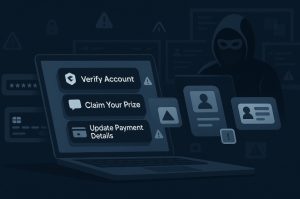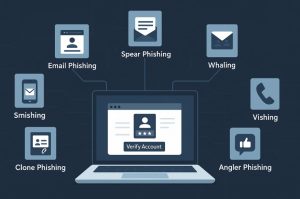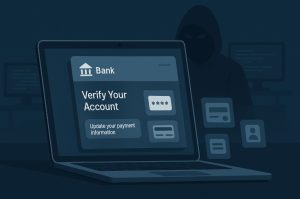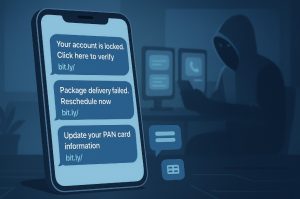
Have you ever received a suspicious email or SMS urging you to update your bank details or click a link urgently? If so, you may have been targeted by a phishing attack, one of the most widespread and deceptive cyber threats in the digital world today.
In the context of cybersecurity, phishing stands out as a particularly dangerous form of attack because it preys not on software flaws or system vulnerabilities, but on human nature itself.
These attacks are designed to manipulate our trust, sense of urgency, and emotional responses, making them especially effective and hard to detect.
As India’s digital adoption continues to grow, with millions of new users coming online every year, the threat of phishing has also risen sharply.
From fraudulent tax refund notifications to fake courier delivery messages, phishing scams are becoming increasingly personalised and convincing, often indistinguishable from genuine communication.
What Are Phishing Attacks?

Phishing is a social engineering technique used by cybercriminals to deceive individuals into revealing sensitive information, such as passwords, bank account numbers, or personal identity details.
These attacks commonly take the form of emails, text messages (smishing), phone calls (vishing), or fraudulent websites that appear to be legitimate.
The attacker typically masquerades as a trusted entity, a bank, a government agency, or even a colleague, urging the victim to take immediate action. The message often includes a malicious link or attachment that, when clicked, either installs malware or leads to a fake website designed to harvest user credentials.
The term “phishing” dates back to the mid-1990s and is derived from the idea of “fishing” for information by luring users with bait. Today, phishing has evolved into many forms, including spear phishing (targeted), whaling (executive-level targeting), smishing (SMS-based), and even AI-driven phishing bots.
Rather than breaking into secure systems, phishing attackers rely on human error, our tendency to trust, click, or act quickly under pressure. This makes phishing a unique and effective method of exploitation in cybersecurity.
Why Are Phishing Attacks a Major Cybersecurity Concern?
Phishing poses a serious and growing threat to both individuals and organisations because of its low cost, high success rate, and broad impact.
Unlike many other cyberattacks that target software or network vulnerabilities, phishing attacks bypass technical defences by manipulating the human element, the most unpredictable and often weakest link in any security system.
Here’s why phishing is especially concerning:
- It’s easy to launch: With minimal resources, attackers can send thousands of fake emails or messages at once.
- It’s highly effective: A well-crafted message can trick even well-informed users, especially when urgency or fear is involved.
- It leads to bigger breaches: Phishing is often the initial access point for more severe attacks like ransomware, identity theft, and corporate espionage.
- It’s a widespread vector: According to IBM’s 2024 data breach report, phishing is responsible for 15% of all data breaches, costing organisations an average of USD 4.88 million per incident.
In India, the growing use of digital banking, e-commerce, and mobile payments has made users increasingly vulnerable. Scammers impersonate platforms like SBI, Paytm, Amazon, or government tax portals to gain access to personal and financial data. Once this data is obtained, it can be used for unauthorised transactions, identity theft, or even to infiltrate entire networks in corporate environments.
Phishing’s reliance on social engineering makes it incredibly difficult to defend against using technology alone. This is why user education, awareness training, and a proactive security culture are just as vital as technical safeguards in preventing phishing attacks.
What Are the Different Types of Phishing Attacks?

Phishing attacks have evolved significantly over the years, branching into various sophisticated forms that use different communication channels, technologies, and psychological tactics to trick users.
Each type of phishing attack shares the same goal, to deceive the victim into providing sensitive data or taking an action that benefits the attacker, but the methods differ based on the attacker’s target, resources, and objectives.
Below are the most prevalent types of phishing attacks every individual and organisation should be aware of:
What is Email Phishing?

Email phishing is the most traditional and widely used form of phishing. Attackers send out mass emails that appear to come from trusted sources, such as banks, government departments, e-commerce websites, or IT teams. These emails often contain urgent language to pressure recipients into clicking on a malicious link or downloading an infected attachment.
Key characteristics:
- Generic greetings like “Dear Customer”
- Spoofed email addresses that resemble legitimate ones
- Requests to verify account details or reset passwords
- Embedded malicious links or attachments
Example: A user receives an email claiming their SBI account is locked due to suspicious activity, urging them to click a link and log in to resolve the issue. The link leads to a fake website designed to steal credentials.
What is Spear Phishing?

Unlike generic email phishing, spear phishing targets specific individuals or groups. Attackers conduct prior research, such as browsing social media or company websites, to craft highly personalised messages that appear credible.
Key characteristics:
- Personalised greetings and content (e.g., using the recipient’s name, job title, or recent activity)
- Mimicking internal colleagues or trusted vendors
- A specific objective, such as requesting wire transfers or confidential documents
Example: An attacker poses as a company’s HR head and emails an employee asking them to download a “new benefits policy” PDF, which is embedded with malware.
What is Whaling? (CEO Fraud)

Also known as whale phishing, whaling targets senior executives or high-ranking individuals with the authority to approve transactions or access sensitive data. These attacks are usually highly customised and exploit the urgency associated with executive communications.
Key characteristics:
- Mimics communication style of CEOs or directors
- Requests urgent action, such as authorising payments or disclosing data
- Often launched via compromised or spoofed executive accounts
Example: An attacker impersonates a company’s CFO and emails the finance team to urgently transfer funds to a “vendor”, which is actually the attacker’s account.
What is Smishing? (SMS Phishing)

Smishing uses text messages (SMS) to deceive recipients into clicking malicious links or calling fraudulent numbers. With the rise of mobile banking and OTP-based logins in India, smishing has become increasingly common.
Key characteristics:
- Fake alerts about account issues, lottery wins, or package deliveries
- URLs shortened with link shorteners (e.g., bit.ly)
- Pretends to be from trusted services like banks, mobile providers, or courier companies
Example: A user receives an SMS saying their PAN card needs re-verification and provides a link to update details. The link leads to a fake form harvesting personal data.
What is Vishing? (Voice Phishing)

Vishing involves attackers calling the victim directly, often pretending to be from a bank, law enforcement, or government agency. They use social engineering tactics to induce panic and extract personal or financial information over the phone.
Key characteristics:
- Spoofed caller ID to appear legitimate
- Use of fear-based scripts (e.g., tax fraud, account block, or legal action)
- Requests for OTPs, PINs, or payment information
Example: A caller claims to be from the Income Tax Department, informing the victim about unpaid taxes and demanding immediate payment through UPI or credit card.
What is Clone Phishing?

In clone phishing, the attacker takes a legitimate email the recipient has received previously, copies it, and replaces its attachments or links with malicious versions.
Key characteristics:
- Appears to come from a known sender
- Subject lines and content match a previous email thread
- Links or attachments are malicious clones
Example: A cloned “invoice email” from a known supplier is resent with a malicious macro-laden document attached.
What is Business Email Compromise (BEC)?

BEC attacks aim to steal money or data by compromising legitimate business email accounts. They often begin with spear phishing and evolve into complex schemes.
Types of BEC attacks:
- CEO fraud: Posing as senior executives to instruct fraudulent actions.
- Vendor email compromise: Impersonating vendors to send fake invoices.
Example: An attacker gains access to a vendor’s email and sends a fake invoice to the accounts department of a client organisation.
What is Evil Twin Wi-Fi Phishing?

This method involves setting up a fake Wi-Fi hotspot, usually in public places like airports or cafes—with a name similar to the real network. Once connected, victims are monitored or redirected to malicious websites.
Key characteristics:
- Deceptively named Wi-Fi networks
- No password or open access
- Fake login portals
Example: A user connects to “Starbucks_FreeWiFi” instead of “Starbucks_WiFi” and is redirected to a phishing login page.
What is Pharming?

Pharming manipulates a website’s DNS settings or redirects users to a fraudulent site, even when they type in the correct URL.
Key characteristics:
- No visible signs to the end user
- Spoofed websites appear identical to the original
- Often results from malware or DNS hijacking
Example: A user types “www.icicibank.com” but is taken to a fake site designed to collect login credentials.
What is Angler Phishing?

This form of phishing uses social media platforms to lure victims. Attackers pose as customer support agents, brands, or trusted influencers.
Key characteristics:
- Replies to customer complaints or inquiries on social media
- Use of lookalike brand accounts
- Links to malicious customer service portals
Example: A fake Twitter account replies to a complaint about an airline, directing the user to a phishing site for “assistance”.
What is Watering Hole Attacks?

Attackers identify and compromise websites frequently visited by their target audience. They inject malicious code that either downloads malware or redirects users to phishing sites.
Key characteristics:
- Exploits trusted websites
- Uses drive-by downloads or malicious scripts
- Often used in targeted attacks against organisations
Example: A government official visits a compromised news site. The injected code silently installs malware to spy on communications.
What is Quishing (QR Code Phishing)?

Quishing uses QR codes to redirect users to malicious sites. Since QR codes are hard to verify visually, users are often unaware of where they’re being redirected.
Key characteristics:
- Fake QR codes in public places, emails, or packages
- Disguised as promotional offers or login portals
- Often bypasses spam filters
Example: A fake parking QR code redirects users to a fraudulent payment page.
How Do Phishing Attacks Actually Work?
Phishing attacks follow a common structure but vary in execution:
- Research & Setup: Attackers gather information about their targets and craft deceptive content.
- Launch: Emails, SMS, or voice messages are sent, urging recipients to take quick action.
- Exploitation: Victims click links, download malware, or submit sensitive data.
- Data Harvesting: Stolen credentials are used to access systems or perform financial fraud.
Attackers often embed malicious links in logos or hide them behind shortened URLs. Others use convincing email templates or spoofed sender domains that closely resemble legitimate ones, for instance, replacing “microsoft.com” with “rnicrosoft.com”.
Why Is Phishing Such a Serious Problem?

Phishing remains one of the most prevalent cyber threats globally because it’s cheap to execute, hard to detect, and extremely effective. Rather than exploiting technical systems, phishing exploits people,the weakest link in the security chain.
Key reasons why phishing is dangerous:
- High success rate: Even a single click can lead to a full system compromise.
- Costly breaches: According to IBM’s Cost of a Data Breach report, phishing accounts for 15% of all breaches, costing organisations an average of USD 4.88 million.
- Escalation to APTs: Phishing is often the first stage in larger attacks like ransomware or advanced persistent threats (APTs).
- Cross-sector impact: Individuals, businesses, and government agencies are all targets.
This is why a layered defence strategy combining user awareness, cybersecurity services, and professional network management services is essential to proactively detect and neutralise phishing threats before they escalate.
What Are Some Real-World Phishing Scenarios?
- Fake Invoices: An attacker sends an invoice resembling a legitimate vendor’s, requesting urgent payment.
- Credential Harvesting: A spoofed email asks users to reset passwords, redirecting them to a fake login page.
- Package Scams: Victims receive fake FedEx messages prompting them to download “delivery receipts” laced with malware.
- Tax Refund Hoaxes: Users are lured into entering details on fake government portals mimicking sites like gov.uk or income tax portals in India.
These examples highlight how attackers rely on urgency, fear, and official-looking content to bypass users’ judgment.
What Techniques Do Cybercriminals Use in Phishing?
Cybercriminals use several tactics designed to manipulate recipients and bypass standard security tools:
- Malicious Web Links: These redirect users to fraudulent websites that steal credentials or install malware.
- Malicious Attachments: Disguised as invoices or receipts, these files often contain macros or scripts to execute malware.
- Fraudulent Data Entry Forms: Users are tricked into filling fake forms mimicking trusted platforms (e.g. banks, government sites).
What Industries Are Most Targeted by Phishing Attacks?
Attackers tend to target industries with access to sensitive or financial data. Top targets include:
| Industry | Percentage of Attacks | Reason for Targeting |
| Financial Services | 13% | Access to bank accounts and credit card data |
| Social Media | 30% | Access to personal data, wide user base |
| eCommerce/Retail | 8% | Access to payment details during transactions |
| Technology | 80% (cyber crimes share) | Privileged access, widespread adoption |
| Telecom | 4.9% | Customer databases and service infrastructure |
| Healthcare | Growing rapidly | Patient data and medical records |
| Logistics & Shipping | 3.1% | Shipment details, IoT vulnerabilities |
| Travel & Hospitality | Seasonal | Loyalty program theft and fake bookings |
How Is AI Evolving and Advancing Phishing Attacks?

AI is transforming both offensive and defensive phishing landscapes:
How AI Helps Attackers?
- Hyper-Personalisation: Scams now mimic writing styles or reference personal data.
- Voice and Video Deepfakes: Vishing becomes more convincing.
- Chatbot Phishing: AI bots engage users in conversations to extract data.
- Quishing: Fake QR codes used in emails, public spaces, and product packaging.
How AI Helps Defenders?
- Real-Time Analysis: AI can block phishing attempts before they reach inboxes.
- Visual Recognition: AI tools analyse page design for visual phishing clues.
- Behavioural Modelling: Anomalous user actions trigger alerts.
- Machine Learning Detection: Patterns learned from past scams improve detection.
How Can You Identify a Phishing Message?
Watch for these common signs of phishing:
- Requests for urgent action or payment
- Unusual sender addresses or domain names
- Spelling or grammatical errors
- Unexpected attachments or popups
- Poor design quality in emails or websites
- Generic greetings like “Dear User”
How Can Individuals and Organisations Prevent Phishing?

What are Individual Measures:
- Don’t click suspicious links, type URLs manually.
- Use multi-factor authentication (MFA).
- Keep devices and software up to date.
- Use antivirus and anti-malware solutions.
What are Enterprise Measures:
- Conduct regular phishing simulations.
- Implement email filtering and URL rewriting.
- Adopt Zero Trust Architecture.
- Educate employees with real-world phishing examples.
- Enforce password policies and 2FA.
As Proofpoint’s Ryan Kalember noted, “74% of breaches still centre on the human element.” So, technical tools must be paired with user training and awareness.
What To Do If You’ve Been Phished?
If you suspect you’ve fallen victim:
- Change all passwords immediately.
- Notify your bank or service provider.
- Report the incident to the CERT-In or your local cybercrime unit.
- Run a complete system scan using updated antivirus software.
- Inform your IT department if it’s a workplace incident.
FAQs on Phishing in Cybersecurity
What makes phishing more dangerous than traditional hacking?
It targets people, not systems, making it harder to detect with standard tools.
How effective is AI in detecting phishing?
AI detects complex threats in real time, making it more reliable than static filters.
Is phishing still growing despite awareness?
Yes, attackers are getting smarter and leveraging AI to increase their success.
What role does social media play in phishing?
Attackers use social media to gather personal info or conduct phishing via DMs.
Can phishing lead to ransomware attacks?
Yes, phishing often acts as the delivery method for ransomware and other malware.
How often should employees receive training?
Ideally quarterly, with simulated phishing exercises to reinforce knowledge.
What is quishing and why is it rising?
Quishing uses fake QR codes to lead users to phishing sites; it’s harder to detect.